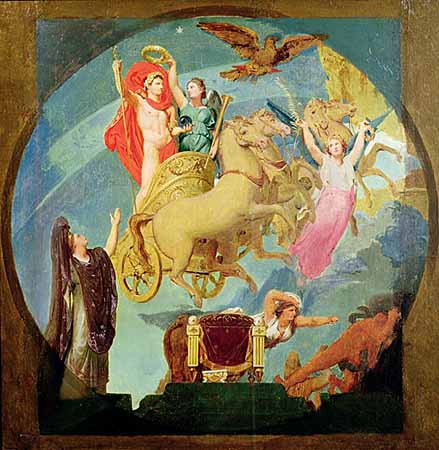After the coup d’état in 1851, Ingres, a partisan of the new government, made no effort to hide his support for Louis-Napoleon Bonaparte. His admiration for the nephew of Napoleon I, and his support for the imperial regime saw him receive and accept a commission which was probably made through the Prince Napoleon. On 2 March, 1853, the painter, at this point seventy-three years old, agreed to a contract committing him to completing before the end of that same year not only The Apotheosis of Napoleon I, a monumental work that would adorn the ceiling of the Salon de l’Empereur in the Hôtel de Ville in Paris, but also eight decorative panels depicting the eight principal cities linked to the history of First Empire: Rome, Milan, Naples, Berlin, Vienna, Moscow, Madrid and Cairo. Painted with help from his students, The Apotheosis of Napoleon I was indeed completed at the end of the year, in a large workshop rented from the sculptor Gatteaux found at 47 rue de Lille, next-door to the artist’s home. It was also here that Napoleon III and Eugenie came to admire the work at the end of January, 1854. And although Ingres had refused to participate in any of the artistic Salons since 1834, he acquiesced, out of respect for the Emperor, to a retrospective featuring the painting at the Universal Exhibition of 1855. There, the Apotheosis of Napoleon I took its place opposite Ingres’ painting of Homer’s own deification, painted in 1827. The accompanying booklet made plain the allegory: “[Napoleon] is taken, by chariot, to the temple of Glory and Immortality; Pheme crowns him and Victory drives his horses; France mourns his passing; Nemesis, the goddess of vengeance, strikes down Anarchy.”
The original painting, along with its companion piece, the Delacroix ceiling known as La Paix vient consoler les hommes et ramène l’abondance, (see here a copy) was destroyed during the fire at the Hôtel de Ville in May 1871. All that remained of it was a photograph of it on display at the Universal Exhibition and various painted sketches and preparatory drawings. This modello held in the Musée Carnavalet and the water-colour in the Louvre nevertheless give an accurate idea of the composition of the painting. In the same vein as the Roman apotheoses of old, the canvas bore a political message rarely found in Ingres’ works. The inscription found on the throne’s arm-rests, “in nepote redivivus” (“he lives again through his nephew”), rendered this panegyric to the Napoleonic dynasty all the more unequivocal during the Second Empire. The deification of Napoleon, although not a new theme (it features heavily in Ingres’ portrait of Napoleon on the Imperial throne, painted forty-eight years previously), here takes a more academic form, a style greatly appreciated by the Imperial government. And following another imperial commission, Ingres produced a model drawing of the composition for a sardonyx cameo produced by Adolphe David.
Karine Huguenaud (tr. H.D.W.)
January 2010


